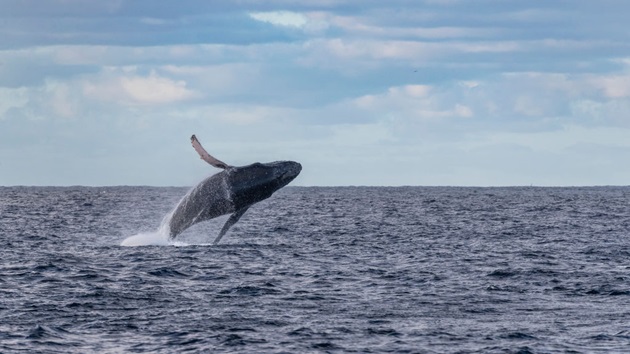(SAN FRANCISCO) — The intersection of marine biology and artificial intelligence technology has led to a startling humpback whale population discovery.
Approximately 7,000 humpback whales in the North Pacific Ocean died between 2012 and 2021 after the damaging effects of a yearslong marine heatwave, according to a study published Wednesday by Royal Society Open Science. It represented a 20% decline during this period.
The marine heatwave began in 2013 and lasted until 2021, steeply raising water temperatures and decreasing ocean productivity worldwide.
In the North Pacific, the study found the humpback whale population dwindled from 33,500 in 2012 to 26,500 by 2021.
The massive, international study gathered data and images from 46 organizations and 4,292 community science contributors and used AI technology to match and identify humpback whales around the world efficiently.
“We brought together data for over 30,000 individual humpback whales in over 200,000 encounters, something that would have been effectively impossible without AI-powered automated image recognition,” Dr. Ted Cheeseman, lead researcher of the study, told ABC News. “It changes the landscape of research, providing a cost-effective tool that gives us some hope of keeping up with the pace of ecosystem change.”
In the past, whale populations were estimated by methods such as manual ship surveys, with much smaller sample sizes, but the implementation of AI matching techniques allowed for more widespread data to be included — and showed the substantial population decline of humpback whales in the North Pacific, according to the study.
AI technology used photo matching to identify individual humpback whales based on the shape of their tail flukes and their pigment patterns.
“I’m excited because this pioneers a new way of doing research,” John Calambokidis, senior research biologist and co-author of the study, told ABC News. “It brings more researchers and people together and creates a more collaborative and supportive atmosphere for research going forward.”
The humpback whale images and data were aggregated via a platform called Happywhale, where researchers and whale watchers alike submitted whale photos for this study and future research.
So far, nearly 800,000 photos have been submitted to Happywhale, which has led to the identification of more than 100,000 individual whales, according to the site.
“One of the exciting developments of Happywhale, crowdsourcing, and automated matching, is that it led to more contributions by citizen scientists and whale watchers,” Calambokidis said.
“We’re learning that the changes going on in the environment can have huge consequences to long-lived species, like whales, that people cherish and value,” Calambokidis said, noting, “This is important to motivate protection and conservation.”
Despite the remarkable recovery in humpback whale populations after the International Whaling Commission banned commercial whaling in 1986, Calambokidis said this comprehensive study shows the stark reality of climate change’s impact on marine life.
“It’s only been in more recent years that scientists really have gotten a handle on how whale populations recovered from commercial whaling,” Calambokidis said.
Calambokidis noted that despite humpback populations increasing along the U.S. West Coast, this international study shows, “Overall, the humpback population has declined in recent years. It seems to be related to climate-driven changes that have lowered the carrying capacity for humpback whales.”
The marine heatwave — referred to by researchers as “the blob” — had a sweeping impact on the ecosystem from phytoplankton lacking nutrients all the way up the food chain to whales, sea lions, and sea birds facing food shortages.
“The aspects that are distressing are the magnitude and the duration of these cyclical patterns that are naturally occurring,” Dr. Ari Friedlaender, a professor of ocean studies at UC Santa Cruz told ABC News.
“Animals may be able to withstand shorter or less frequent marine heatwaves, but if they become more common and bigger anomalies, then it becomes very challenging for ecosystems to handle.”
Commenting on the impact of the study, Friedlaender said, “It raises the flag, but it doesn’t answer the question of how do we protect and conserve these animals?”
Copyright © 2024, ABC Audio. All rights reserved.












